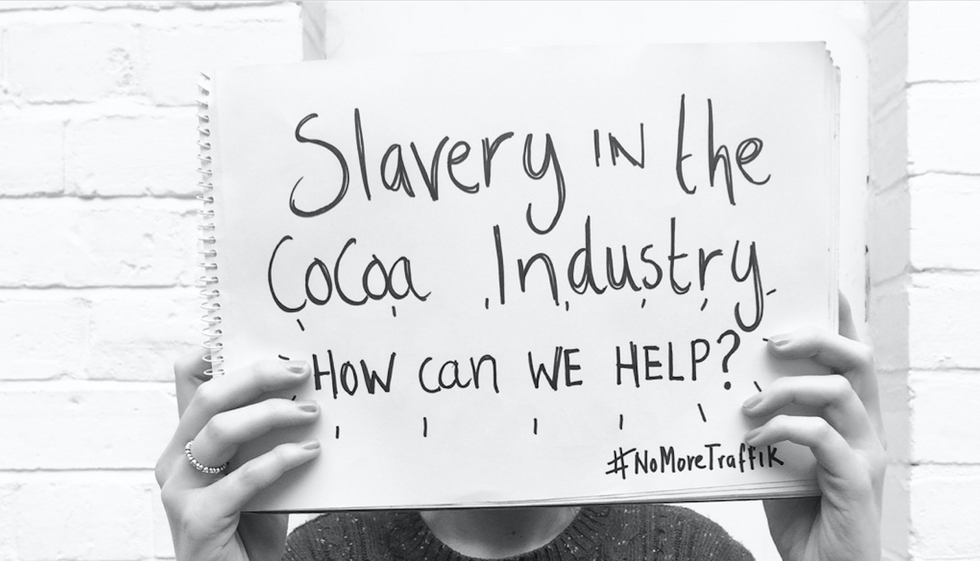In 2015, Americans spent $2.2 billion on Easter candy alone. It is projected that by 2019, the US Chocolate market will hit $25 billion. Nearly 75 percent of the world’s cocoa bean supply that will be used to produce this chocolate is grown on farms in West Africa. However, the unspoken reality of the cocoa industry is that the need for cheap cocoa has driven industry giants to exploit cheap labor, namely that of children and their families.
Almost 200,000 children in the Ivory Coast alone – the world’s largest cocoa producer – are effectively modern-day slaves, forced to work in cocoa plantations with abrasive chemical substances and without protective equipment. According to the United States Department of Labor, 40% of these children do not go to school and over 50% of them suffer from work-related injuries. Most children are not compensated, but for those cocoa growers who are, 3.5 to 6.4 percent of the retail value of the chocolate bar produced by their beans is their “salary” – merely 3 to 6 pennies for a $1 chocolate.
As revealed by the 2010 documentary film called “The Dark Side of Chocolate,” some children who work on cocoa plantations are initially obtained through kidnapping in public village markets while others are victims of human trafficking; a bus station in Sikasso, Mali serves as one departure site for children who are trafficked in groups of 10-15 across the border to the Ivory Coast and housed in the village of Korogho before being sold to local farmers.
These human rights violations still exist in spite of the 2001 Harken-Engel protocol, also known as the Cocoa protocol. Signed by 8 of the largest cocoa companies, this was a voluntary agreement which laid out a series of voluntary standards to help eradicate child labor by 2008. In September 2010, the US Secretary of Labor, Labor Ministers of Ghana and the Ivory Coast and the President of the National Confectioners Association signed a Declaration to support the implementation of the protocol and reduce only the “worst forms” of child labor in the region by 70% by 2020. In September 2011, 8 chocolate companies including Ferrero, Mars, and Nestle pledged $2 million in partnership with the International Labor Organization (ILO) to help combat child labor in Ghana and the Ivory Coast. While such efforts are a step towards realizing human rights for all, the urgency of this injustice necessitates immediacy and the eradication of all forms of child labor and trafficking embedded within the industry, rather than a relaxed, non-urgent approach of incrementalism.
Modern-day slavery does not end at the chocolate industry; as revealed by a recent Sky News Investigation, child labor is exercised at cobalt mines as well. It is for this reason that we should utilize our power as consumers to choose to consume with a conscience. Purchasing Fair Trade goods from brands like Mama Ganache, Camino and Equal Exchange this Easter will ensure a responsibly-sourced product and labor process (More ethical chocolate brands can be found on World Vision’s “Good Chocolate Guide" list). You can also start or sign a petition to make sure your favorite chocolate company takes action to end any involvement of child labor or trafficking in their supply chains; one such petition to Lindt and Ferrero chocolates resulted in promises to have supply chains “100% audited by 2020.” You can also participate in Stop The Traffik’s Easter Action campaign, by writing to your local supermarket manager asking that they only buy and stock slave-free chocolate. You can continue reading for more ideas on how to help stop modern-day slavery here.
When we purchase and indulge in our chocolate Easter baskets this April, we are indirectly contributing to the criminal enterprise of modern-day slavery and the dehumanization of children and other families. At a time in which fellow Christians celebrate rebirth and rejoice in the resurrection of Our Lord, the chocolate bunnies which have become synonymous images with this celebration also remind us of a dark truth; while First World children enjoy their sweet treats, children elsewhere struggle to cope with their bitter status of exploitation. Let us consider this reprehensible reality when deciding which Easter basket to purchase this Spring.



















